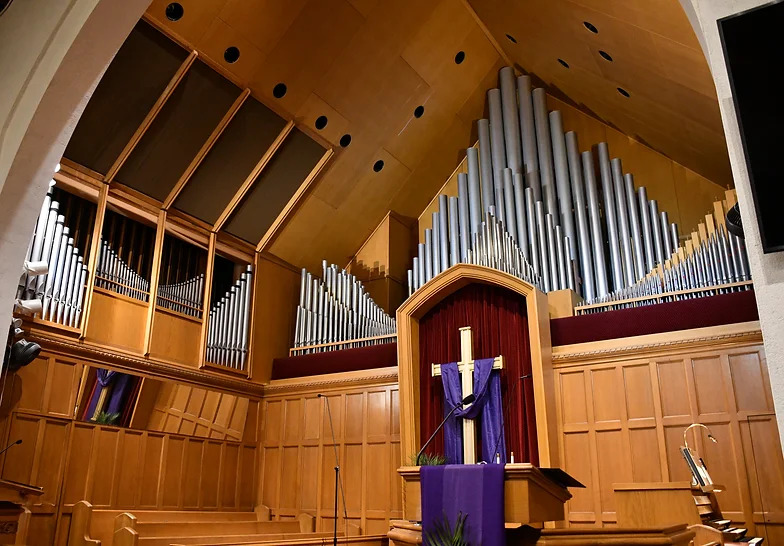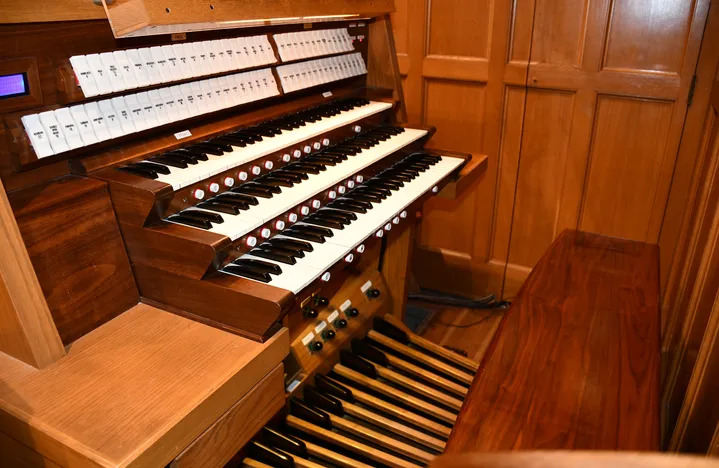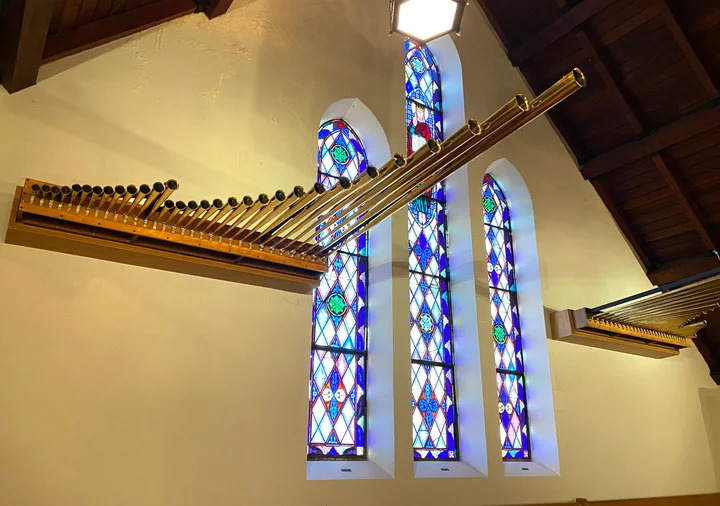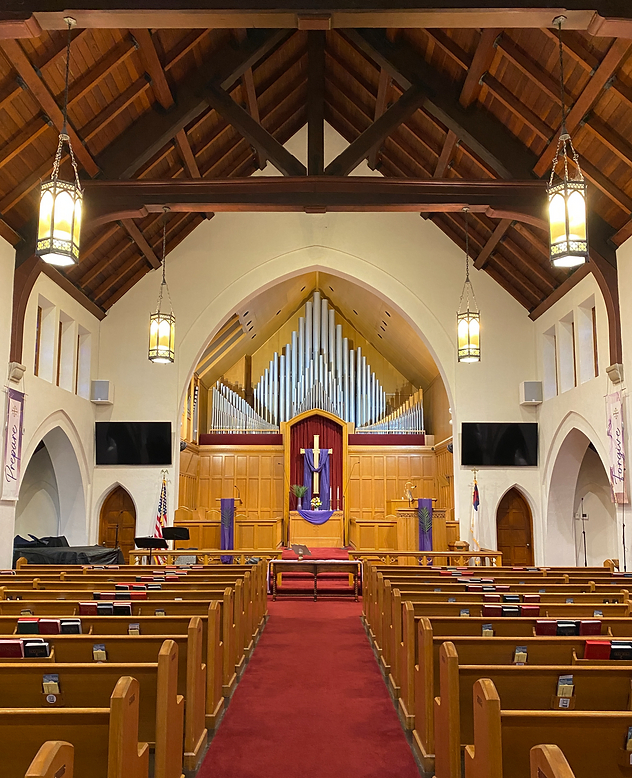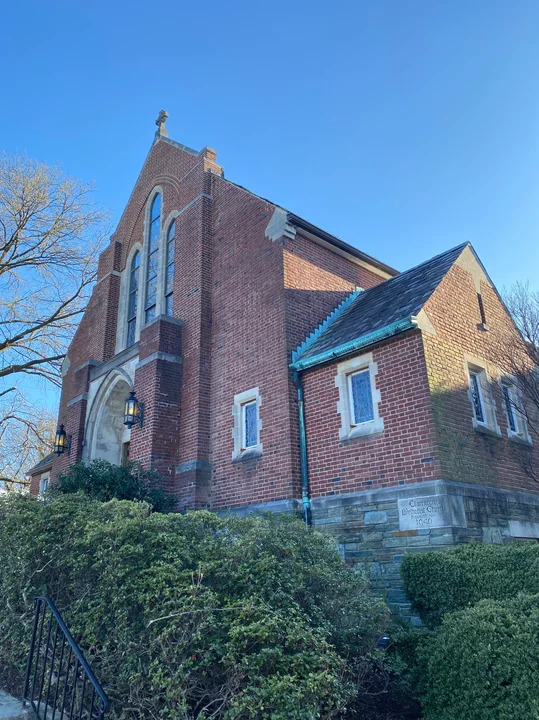Arlington, Clarendon United Methodist Church
| Builder | Schlicker Organ Company |
|---|---|
| Year | ca. 1967 |
| Period/Style | Neo-Baroque |
| Stops | 50 |
| Keyboards | 3+P |
| Keyaction | electrical |
| Tuning | Equal at 440 Hz |
| Sampleset |
Available
 , sampled by
Coral Pipes
, sampled by
Coral Pipes
|
Clarendon United Methodist Church was founded in 1901 in Arlington, Virginia. Its beautiful 1967 Schlicker organ is largely in its original state with only a few improvements added over the years. The original Schlicker part of the instrument remains tonally unaltered. This organ is built in the typical Schlicker style with bright principal choruses and mixtures well suited for Baroque and Modern music, though with appropriate registration, the organ can play a wide range of literature.
The church’s first building was constructed in 1906 and was located a few blocks away from its present location. The current sanctuary was completed in 1941 and the rest of the building was added on in 1951. Clarendon United Methodist’s first organ was installed by the Pilcher organ company in 1941. The organ was purchased as a gift and included a set of chimes, which are still in the organ today. Little else is known about the Pilcher organ. In the late 1950s, the church hired an organ consultant, Dr. Harold Gleason, to evaluate the state of the organ, and the consultant determined that the organ no longer fit the congregation's needs and a new organ was needed. Nearly ten years later, the Music Committee responsible for the new organ chose the Schlicker Organ Company of Buffalo, New York, to build the church’s new instrument. The new pipe organ was designed in collaboration by Herman Schlicker and Dr. Gleason. It was installed in 1967 and inaugurated in a series of four concerts played by Frederick Swann, Oswald Ragatz, David McBride, and John Wigent. Shortly after, in 1971, Reilly Lewis, founder of the Washington Bach Consort and music director of the Cathedral Choral Society at the Washington National Cathedral, took the position of Organist and Choirmaster.
When the Schlicker organ was installed in 1967, it consisted of 39 ranks, the chimes from the Pilcher organ, and several stops that were prepared for future installation. Over the next couple of years, pipes for the prepared stops were added. The next major change occurred in 1990 with the addition of the all-brass en chamade Antiphonal Trumpet built by the English firm F.J. Rodgers and installed by the Di Gennaro-Hart Organ Company. In the early 2000s, four digital stops were added to better equip the organ for more styles of music. These include the Pedal Bourdon 32, Contra Posaune 32, Double Open Wood 16, and the Swell Trumpet 8. These digital stops have all been recreated in the sample set with recordings from other pipe organs of similar style. Additionally, in the pipe organ, the Pedal Principal 16 was extended to 61 notes such that it could play in the Great as the Prestant 16. This too has been recreated in the sample set. The organ now contains 47 ranks of pipes along with the digital stops.
The organ is mostly unenclosed and displayed at the front of the room. The Great division is located on the left side of the exposed pipes, and the Positiv division is located on the right side of the exposed pipes. The Pedal upperwork sits between the Great and the Positiv, and the Pedal’s large bass pipes lie behind the rest of the organ. The Swell division is enclosed on the left side of the altar.
The Great is based upon a strong principal chorus, extending from the strong Prestant 16 through a bright five rank mixture. The Great also has a particularly beautiful set of flutes extending (virtually) through 2 ft. To top it all off, the Great has bright Germanic trumpets at 8 and 4. Finally, the Great has the original Pilcher chimes that work very well with the quiet Swell stops.
The Swell too has a brilliant principal chorus that is a smaller alternative to the Great’s. It begins with a Principal 8 and continues up through a delicate 2 ft Blockfloete and a bright and pleasant four rank mixture. The Swell also has four ranks of strings. There are two violes, which are louder and slightly brighter than the other two ranks, the Dolce and accompanying Dolce Celeste. Like the Great, the Swell also has gorgeous flutes in 8, 4, and 2 that work very well complementing both the principals and the strings. The Swell has a battery of reeds, including a warm oboe and a French-styled trumpet. The Swell division has a tremulant that can add additional color.
The Positiv is an interesting division made of some of the most delicate stops on the organ. It is based upon a present and beautiful Gedackt 8. This Gedackt can then be built upon by principals at 4 and 2 ft and by a Koppelfloete 4 that acts as a 4 ft complement to the Gedackt. The tremulant adds another beautiful layer to these amazing stops. The upperwork adds sharpness and brilliance to the division and enables some of the signature Schlicker gap registrations. To cap off the Positiv (and the entire organ), there is a four rank Cymbel. Finally, there is an 8 ft Krummhorn that acts as a color reed and is very effective for French Baroque music.
The Pedal is a strong division composed primarily of 16 ft flutes and diapasons to act as a base to the rest of the organ. In addition, the Pedal also contains a strong upperwork with a colorful Nachthorn 2 and a potent Mixture III. The Pedal also has a full complement of reeds ranging from 32 ft to 8 ft. One of the most fun ranks of the entire instrument is the powerful Antiphonal Trumpet 8 that is non-coupling and playable from all divisions. It cuts through the rest of the organ (including the very high pitched Cymbel IV). It can play the role of a large trumpet for trumpet tunes or for soloing out hymn tunes.
Overall, this organ excels at Baroque and Modern music, but due to its large Swell divisions and amazing, colorful flutes, the organ can also play Romantic music with appropriate registration. It also does very well at accompanying church services and congregational singing.
The church’s first building was constructed in 1906 and was located a few blocks away from its present location. The current sanctuary was completed in 1941 and the rest of the building was added on in 1951. Clarendon United Methodist’s first organ was installed by the Pilcher organ company in 1941. The organ was purchased as a gift and included a set of chimes, which are still in the organ today. Little else is known about the Pilcher organ. In the late 1950s, the church hired an organ consultant, Dr. Harold Gleason, to evaluate the state of the organ, and the consultant determined that the organ no longer fit the congregation's needs and a new organ was needed. Nearly ten years later, the Music Committee responsible for the new organ chose the Schlicker Organ Company of Buffalo, New York, to build the church’s new instrument. The new pipe organ was designed in collaboration by Herman Schlicker and Dr. Gleason. It was installed in 1967 and inaugurated in a series of four concerts played by Frederick Swann, Oswald Ragatz, David McBride, and John Wigent. Shortly after, in 1971, Reilly Lewis, founder of the Washington Bach Consort and music director of the Cathedral Choral Society at the Washington National Cathedral, took the position of Organist and Choirmaster.
When the Schlicker organ was installed in 1967, it consisted of 39 ranks, the chimes from the Pilcher organ, and several stops that were prepared for future installation. Over the next couple of years, pipes for the prepared stops were added. The next major change occurred in 1990 with the addition of the all-brass en chamade Antiphonal Trumpet built by the English firm F.J. Rodgers and installed by the Di Gennaro-Hart Organ Company. In the early 2000s, four digital stops were added to better equip the organ for more styles of music. These include the Pedal Bourdon 32, Contra Posaune 32, Double Open Wood 16, and the Swell Trumpet 8. These digital stops have all been recreated in the sample set with recordings from other pipe organs of similar style. Additionally, in the pipe organ, the Pedal Principal 16 was extended to 61 notes such that it could play in the Great as the Prestant 16. This too has been recreated in the sample set. The organ now contains 47 ranks of pipes along with the digital stops.
The organ is mostly unenclosed and displayed at the front of the room. The Great division is located on the left side of the exposed pipes, and the Positiv division is located on the right side of the exposed pipes. The Pedal upperwork sits between the Great and the Positiv, and the Pedal’s large bass pipes lie behind the rest of the organ. The Swell division is enclosed on the left side of the altar.
The Great is based upon a strong principal chorus, extending from the strong Prestant 16 through a bright five rank mixture. The Great also has a particularly beautiful set of flutes extending (virtually) through 2 ft. To top it all off, the Great has bright Germanic trumpets at 8 and 4. Finally, the Great has the original Pilcher chimes that work very well with the quiet Swell stops.
The Swell too has a brilliant principal chorus that is a smaller alternative to the Great’s. It begins with a Principal 8 and continues up through a delicate 2 ft Blockfloete and a bright and pleasant four rank mixture. The Swell also has four ranks of strings. There are two violes, which are louder and slightly brighter than the other two ranks, the Dolce and accompanying Dolce Celeste. Like the Great, the Swell also has gorgeous flutes in 8, 4, and 2 that work very well complementing both the principals and the strings. The Swell has a battery of reeds, including a warm oboe and a French-styled trumpet. The Swell division has a tremulant that can add additional color.
The Positiv is an interesting division made of some of the most delicate stops on the organ. It is based upon a present and beautiful Gedackt 8. This Gedackt can then be built upon by principals at 4 and 2 ft and by a Koppelfloete 4 that acts as a 4 ft complement to the Gedackt. The tremulant adds another beautiful layer to these amazing stops. The upperwork adds sharpness and brilliance to the division and enables some of the signature Schlicker gap registrations. To cap off the Positiv (and the entire organ), there is a four rank Cymbel. Finally, there is an 8 ft Krummhorn that acts as a color reed and is very effective for French Baroque music.
The Pedal is a strong division composed primarily of 16 ft flutes and diapasons to act as a base to the rest of the organ. In addition, the Pedal also contains a strong upperwork with a colorful Nachthorn 2 and a potent Mixture III. The Pedal also has a full complement of reeds ranging from 32 ft to 8 ft. One of the most fun ranks of the entire instrument is the powerful Antiphonal Trumpet 8 that is non-coupling and playable from all divisions. It cuts through the rest of the organ (including the very high pitched Cymbel IV). It can play the role of a large trumpet for trumpet tunes or for soloing out hymn tunes.
Overall, this organ excels at Baroque and Modern music, but due to its large Swell divisions and amazing, colorful flutes, the organ can also play Romantic music with appropriate registration. It also does very well at accompanying church services and congregational singing.
| Positiv | Great | Swell | Pedal |
|---|---|---|---|
| Gedackt 8 | Prestant 16 (Ped) | Rohrfloete 8 | Bourdon 32 (Walker Digital) |
| Koppelfloete 4 | Quintadena 16 | Viole 8 | Double Open Wood (Walker Digital) |
| Principal 2 | Principal 8 | Viole Celeste 8 (T.C.) | Principal 16 |
| Larigot 1 1/3 | Spillfloete 8 | Dolce 8 | Subbass 16 |
| Siffloete 1 | Octave 4 | Principal 4 | Quintadena 16 (Grt) |
| Cymbel IV | Hohlfloete 4 | Spitzfloete 4 | Octave 8 |
| Krummhorn 8 | Octave 2 | Blockfloete 2 | Bass Flute 8 |
| Antiphonal Trumpet 8 (Di Gennaro-Hart) | Mixture V | Sesquialtera II | Quintadena 8 (Grt) |
| Trumpet 8 | Mixture IV | Choralbass 4 | |
| Chimes | Fagott 16 | Quintadena 4 (Grt) | |
| Trumpet 8 (Walker Digital) | Nachthorn 2 | ||
| Oboe - Schalmei 8 | Mixture III | ||
| Clarion 4 | Contra Posaune 32 (Walker Digital) | ||
| Antiphonal Trumpet 8 (Di Gennaro-Hart) | Posaune 16 | ||
| Fagott 16 (Swl) | |||
| Trumpet 8 | |||
| Krummhorn 8 (Pos) | |||
| Clarion 4 (Swl) |
Information from console, organ's curator, and dedicatory recital pamphlet
 Pipe Organ Map
Pipe Organ Map